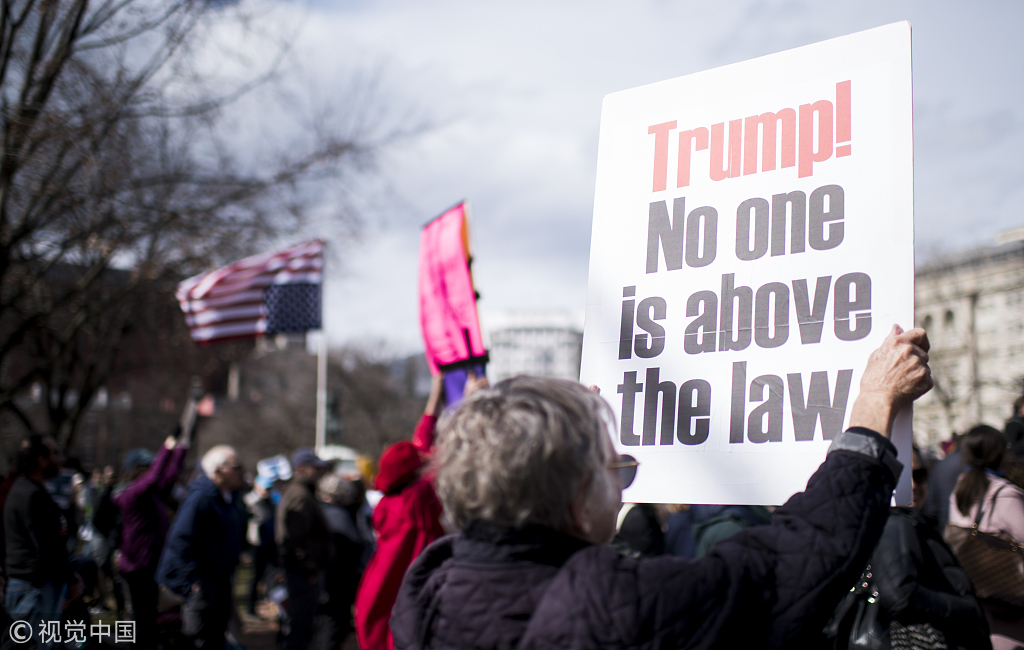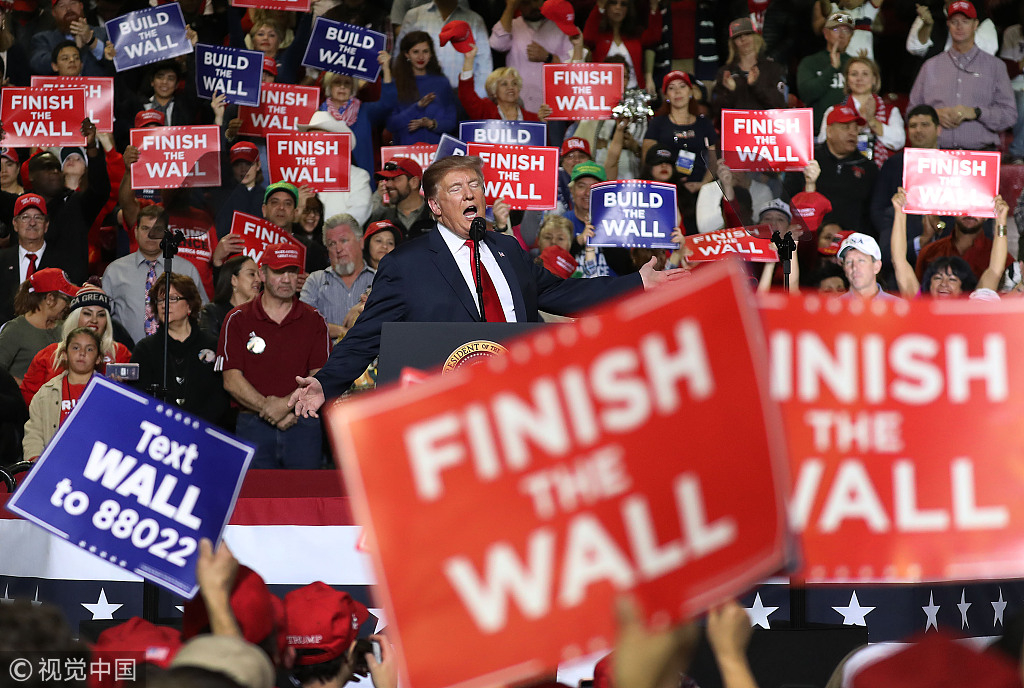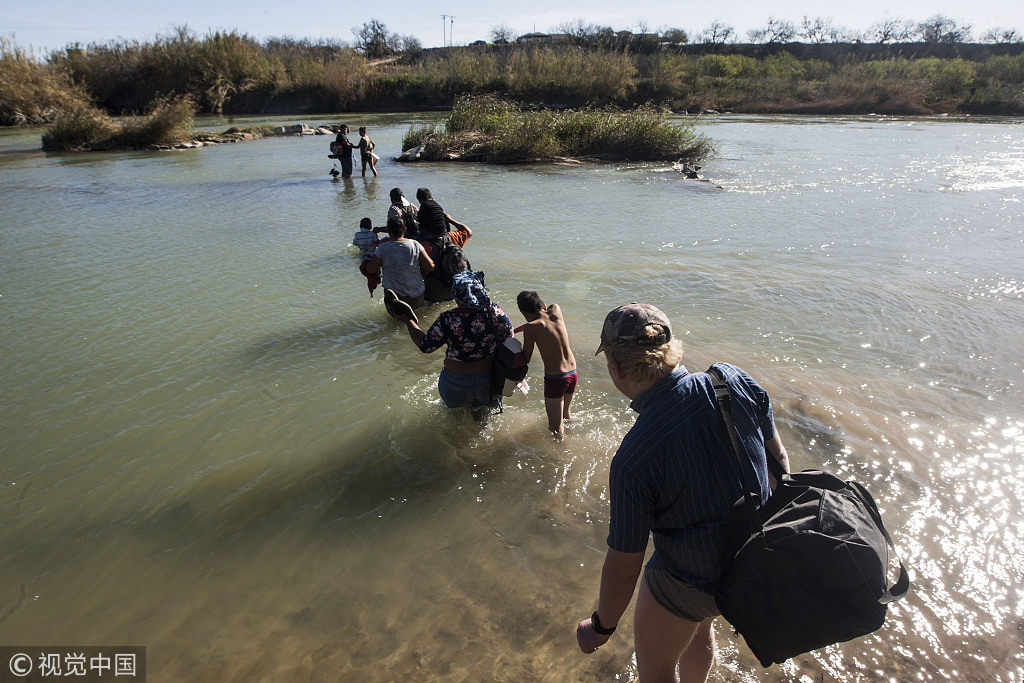
TV Show
12:50, 19-Feb-2019
A better policy, not a wall, is key to U.S. border situation
The Heat
01:16

On February 15, U.S. President Donald Trump declared a national emergency at the U.S. southern border to provide for billions of dollars denied by Congress to build a border wall.
This action caused fierce controversy on the immigration issue and puts the separation of powers in the Constitution in question.
Eleanor Clift, who is a political analyst, thinks that there is no emergency at the border, and even the president contradicted against himself in a news conference at the Rose Garden.
She anticipates that although this decision will be challenged in the courts and the Democratic-led House of Representatives, Trump is still likely to succeed through the Congressional route.
She also points out that there had never been such a controversial use of national powers.

Protesters gather in Lafayette Square across from the White House in Washington, Feb. 18, 2019./ VCG Photo
Protesters gather in Lafayette Square across from the White House in Washington, Feb. 18, 2019./ VCG Photo
John Sitilides, a geopolitical strategist, believes that Trump's act is to execute his promise in the election for his supporters.
He also aims to attract voters who did not vote for him but are against illegal immigration in 2020.
Maria Perez, the associate director at the Atlantic Council Latin America Center, has done much research on the border and says the number of unauthorized migrants passing the border has actually reached the lowest since 1971.
She also points out that a crisis is happening in Central America's Northern Triangle, and most of the drug imports mentioned by Trump come from legal ports of entry, not the border.
Political commentator and talk show host Joe Madison points out that the reason for Trump's act is to avoid Congressional approval. A national emergency should be applied by necessity rather than political expediency.

U.S. President Donald Trump speaks during a rally at the El Paso County Coliseum in El Paso, Texas, February 11, 2019./ VCG Photo
U.S. President Donald Trump speaks during a rally at the El Paso County Coliseum in El Paso, Texas, February 11, 2019./ VCG Photo
Sitilides indicates that the high number of drug imports are mostly due to the incredibly high demand from Central America, where more efforts should be done to destroy the gangs. Madison adds that most of the people on the border are seeking asylum instead of trading drugs.
Eleanor Clift sharply points out that the Trump Resort has, in fact, employed many people who are illegal immigrants.
Madison then mentions the Great Wall as an example to illustrate that walls are not the tools to keep anyone out. He believes that everyone wants America's border to be protected, yet there are many ways other than building a wall.
As the associate director at Atlantic Council Latin America Center, Maria Perez's main job is to convey a realistic picture of the bad situation in the bordering countries.

A section of the border wall is constructed on the U.S. side of the border in Tijuana, Mexico, January 28, 2019./ VCG Photo
A section of the border wall is constructed on the U.S. side of the border in Tijuana, Mexico, January 28, 2019./ VCG Photo
She observes that for migrants, leaving their homes or not is not an existential question. Instead, they are forced to leave their countries, and she agrees with Madison that there are other ways to protect the border.
Sitilides adds that the issue is more about building a better immigration policy rather than a wall. A better immigration policy can protect America's border and at the same time support its neighbors in terms of economic opportunities in the United States.
Madison confirms the idea that the U.S. has always been a country where people go to seek asylum and freedom, and a wall will not stop them.
Perez says that she is seeing many caravans, which provide safety in numbers, as the new way to travel.

Central American migrants trying to cross the Rio Bravo, from Piedras Negras, in Coahuila state, Mexico to the city of Eagle Pass, in Texas, U.S., as seen from Mexico, February 17, 2019./ VCG Photo
Central American migrants trying to cross the Rio Bravo, from Piedras Negras, in Coahuila state, Mexico to the city of Eagle Pass, in Texas, U.S., as seen from Mexico, February 17, 2019./ VCG Photo
The Trump administration is worsening the situation as they make the asylum seekers wait for an even longer time – almost 4 out of 5 applicants from the caravans are denied. She agrees that creating a policy would still be the key to this issue.
(If you want to contribute and have specific expertise, please contact us at opinions@cgtn.com.)

SITEMAP
Copyright © 2018 CGTN. Beijing ICP prepared NO.16065310-3
Copyright © 2018 CGTN. Beijing ICP prepared NO.16065310-3